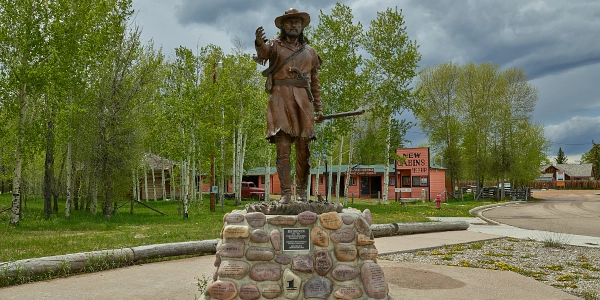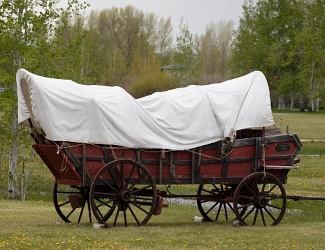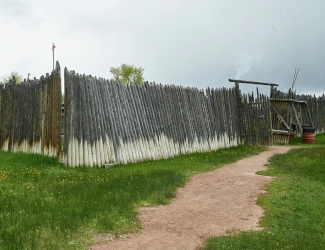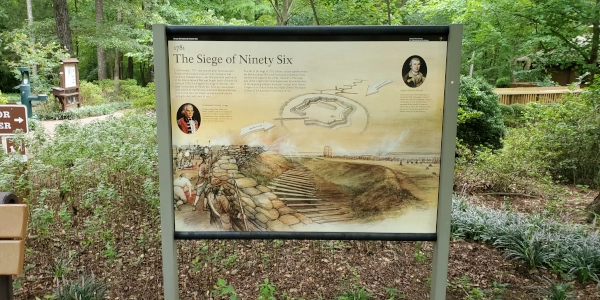
Image above: Entrance sign to Fort Bridger State Historic Site, Fort Bridger, Wyoming, 2016, Carol M. Highsmith. Courtesy Library of Congress.
Spotlight on Lesser Known History
Fort Bridger, Wyoming
America's Best History Spotlight
On this page we're going to Spotlight the lesser known historic sites and attractions that dot the history landscape across the USA and are worth a visit if you're in their area. And while they may be lesser known, some are very unique, and will be that rare find. You'll be, at times, on the ground floor, or maybe even know something others don't. It'll be fun. Visit them.

Fort Bridger, Wyoming
Jim Bridger, mountain man, and his cohort Louis Vasquez thought that a trading post for fur trading and more was needed in this area of southwest Wyoming along the Oregon Trail as more and more wagon trains began to make their way west. It was late 1842 into early 1843. By 1853, the Mormons took over, and eventually Fort Bridger became an Army Post. Today, it's a fantastic state historic site run by, yes, the state of Wyoming. Otherwise that would be odd. Put yourself into the shoes of any of those eras as you walk around twenty-seven historic buildings from the time period. Image above: Statue of Jim Bridger by Dave Clark at Fort Bridger State Historic Site, 2016, Carol M. Highsmith. Courtesy Library of Congress.
Sponsor this page for $100 per year. Your banner or text ad can fill the space above.
Click here to Sponsor the page and how to reserve your ad.
Info, What's There Now, History Nearby

Fort Bridger, Wyoming
In 1842, when Jim Bridger and Louis Vasquez decided to build a trading post at Fort Bridger, it was predominantly still a fur trading area. The complex consisted of two double-log houses with a pen in the middle for their horses. By 1853, use changed, the complex expanded, and the Mormons took over, using the expanded fort more for trade with the settlers who used the Oregon Trail, California Trail, and Mormon Trail for their wagons and horses. During the Utah War, 1857, the Mormons destroyed the fort so the U.S. Army could not use it, but the Army rebuilt the fort in 1858 and used it for over thirty years.
It was during this time, 1860-1861, that the Pony Express used Fort Bridger as a stop along the mail trail. Today, you can follow all those trails; Oregon National Historic Trail,
California National Historic Trail, Mormon Pioneer National Historic Trail, and Pony Express National Historic Trail, all supervised by the National Park Service, although many sites, including Fort Bridger, are not run by the Park Service itself.
Image above: The Pony Express stables at Fort Bridger, 1940, Arthur Rothstein, Office of War Information. Courtesy Library of Congress. Below: Interior of the Fort Bridger stockade, 2016, Carol M. Highsmith. Courtesy Library of Congress.

Where Is It
Located three miles off 1-80, Exit 34, Fort Bridger is in southwest Wyoming. Official address is Fort Bridger State Historic Site, 37000, I-80BL, Fort Bridger, WY 82933. Your GPS and local signage should get you there. Fort Bridger is a very small town.
What is There Now
Fort Bridger
It's a gem of a historic site spanning five different eras. There are twenty-seven historic buildings, four replica buildings, and six modern buildings. There is a museum to visit to see exhibits and get orientation to the site plus thirty-seven acres to explore around Groshen Creek. There are also restrooms and a gift shop.
When Open and How Much
The grounds of Fort Bridger State Historic Site are open year round. The buildings May 1 to September 30, and the museum itself year round with shorter hours October 1 to April 30, Friday through Sunday only. It costs $4.00 for Wyoming resident and $8 for non-Wyoming residents.
Fees and hours are subject to change.
Websites
Fort Bridger State Historic Site
Travel Wyoming
History Nearby
It's the wide open spaces with national parks around many corners and unique state or local historic sites on roads that seem to go nowhere. That includes some of the real stars, Yellowstone, Glacier, etc., as well as places you should not miss, like Cody, Wyoming.
Buy Second Edition
America's Best History Timeline

Great book to keep your youngsters up to date on their history and prepared for that Spring Break interview by Jesse Watters or another man or woman on the street reporter.
Photos, History, and More Spotlights

The Town
The town of Fort Bridger, which, at the time of the construction of the fort and trading post by Jim Bridger and lesser known Mountain Man Pierre Louis Vasquez, the town and fort were synonymous with each other. Today, and since 1843, a small town has grown up around it. Much of that, in its initial years was owned by Jim Bridger himself. He filed a claim with the Land Office for three thousand eight hundred acres around the fort.
Today, Fort Bridger, the town and historic site, is located in eastern Uinta County, Wyoming. In the 2010 census, it had a population of three hundred and forty-five.
Photo above: Conestoga Wagon exhibit at Fort Bridger, the transportation that brought many of the settlers west on the Oregon Trail, 2016, Carol M. Highsmith.

The Trading Post
While there is much known about Jim Bridger as his legend as a fur trader, less is known of his partner in this venture, Louis Vasquez. Vasquez was educated, literate (one of the few who could claim that) and experienced in the fur trade since his license to trade with the Pawnee in 1823. He built Fort Vasquez, another trading post, with William Sublette, in 1835, northeast of Denver, and made frequent trips back to St. Louis. That trading post was not successful and Vasquez sold it in 1840, although, in the end, received no money for it.
Bridger and Vasquez became friends and by 1842 had decided to build the trading post of Fort Bridger along the Green River at Blacks Fork. The date often becomes confused as the fort initial construction likely began in late 1842 and is often credited as opening in 1843. Its intent as a trading post shifted over their ownership into an emigrant waystation for settlers moving along the trails.
The transition to the Mormons began when Bridger and Vasquez owned the fort. Orson Pratt was amongst the first party of Mormons to arrive in July 1847. There was frequent bickering between Bridger and the new arrivals. Bridger was arrested by the Mormon militia in 1853 and sent east, accused of selling alcohol to the Indians against federal law. Bridger returned, but the Mormons had already built another fort, Fort Supply, twelve miles away.
It is reported that the Mormons then bought Fort Bridger from Vasquez in 1855 (deed) 1858 (recording) for $8,000 in gold coins, which Bridger denied. It was, in effect, sold through a power of attorney while Bridger was away.
Photo above: Interior of a cabin at Fort Bridger, 2016, Carol M. Highsmith. Courtesy Library of Congress.

The Mormons and the Army Post
Bridger had leased his surveyed land to the U.S. Army for use during the Utah War on November 18, 1857. Colonel Albert Sidney Johnston was in charge and relations had soured between the U.S. government and the Mormons, replacing Brigham Young with a new governor. As two thousand five hundred troops approached the Mormon forts, the Mormons destroyed Fort Bridger.
Over time, the U.S. Army rebuilt Fort Bridger and expanded its buildings. It remained a trading post as well as fort to establish and make treaties with the tribes of the area, including the Fort Bridger Treaty with the Shoshone and Bannock in 1868. The Army eventually closed the fort in 1890. Expansion of the railroad made many of its forts obsolete.
Photo above: Exterior of the stockade at Fort Bridger, 2016, Carol M. Highsmith. Courtesy Library of Congress.

T-Shirts and Gifts from the official souvenirs of Americasbesthistory.com.
About
America's Best History where we take a look at the timeline of American History and the historic sites and national parks that hold that history within their lands.
Photos courtesy of the Library of Congress, National Archives, National Park Service, americasbesthistory.com and its licensors.
- Contact Us
- About
- © 2022 Americasbesthistory.com.
Template by w3layouts.


